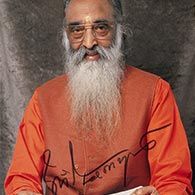Swamiji started with an explanation of the deeper significance of the Lord’s name, Rama and how the celebration of His homecoming also means the celebration of a seeker’s realisation of his own true nature, a true home-coming. Elaborating on the Upanishadic mantra - Asato ma sadgamaya, tamaso ma jyotir gamaya, mrityor ma amritam gamaya – he spoke on the meaning and significance of lighting the lamp. Lamp stands for the Flame of Awareness that is always lit within us. It also symbolises Sri Ganesha, remover of obstacles. Each sense organ is a lamp too. When the senses are all turned inward and hence are quietened, the seeker becomes aware of the Lamp of Awareness. Adi Sankaracharya says this mantra is Abhayaaroha - turning towards the Lord within us and rising to evolve. It is also Pavamaana – purifying, as it can be chanted in havan, done japa of and even used as a prayer. When the seeker chants ‘tamaso ma jyotir gamaya’ - the prayer is that may one be taken from the dark world of ignorance to permanent Light or Self Knowledge.
We are very uncomfortable with death and change, hence we pray that we are taken from Asat to Sat. Narakasura being killed by the Lord is symbolic of our ego being destroyed. The 16,000 women he rescued and then wed are symbolic of those many thoughts that the seeker has overcome, as thoughts are bound to ego. This is the victory of Sat over Asat, when the ego is transcended. We want Amrit, not death.
A powerful feature of the flame is that it always goes up. That is how the seeker’s mind should be, always going up. This path hence requires a lot of strength. Flame is also symbolic of inspiration and evolution. So Deepavali is the time to celebrate inspiration. What is the lamp of inspiration that is lit in our mind? The most inspiring is the quest for Moksha. It is necessary to be rooted in values and festivals are the time to commit and make stronger our commitment to values.
A mind that follows values is light. Swamiji gave Vedantic significance to the days of Diwali - Dhanteras signifies values and virtues. Pure and noble metals such as gold and silver are purchased. These prepare us for Brahma Vidya. Lord Rama’s life is one of uncompromising values and commitment to dharma. The lamp thus symbolises such a dharmic mind, as also signifying viveka shakti which does not allow it to be deluded and distracted. Such a mind is focused and steady, as it is pure. A sharp, subtle and pure intellect is one that is ready to receive Atma gyaan. The flame represents so much. Fire is also a purifier, since it burns. There is no greater purifier than knowledge, which is symbolised by this fire. The constant flame of awareness of ‘Aham’ that is never absent is the most powerful and may we realise this Light! To explain this, Swamiji spoke of the Light that is the cause of all lights outside and within, with the chanting of ‘na tatra suryo bhaati na chandra taarakam, nema vidyuto bhaanti kutoyam agnihi, tameva bhaantam anubhaati sarvam, tasya bhaasa saravam idam vibhaati’ as also a verse of Brahmagyanaavali.
The journey is from thinking we are illumined to realising that we are the Illuminator! It is said in the scriptures that entire creation rejoices when someone realises the Truth. That is the power of Deepavali. It is a spiritual festival with Dhanteras signifying the pure and dharmic life which is the preparation. Naraka Chaturdashi is the freeing of the mind from the ego which is destroyed.
Then comes Amavasya, complete darkness, where the mind (symbolised by the moon in our scriptures) is transcended. When we live with this new vision that I am not the Body, the Mind nor the Intellect, it is a celebration of a New Year! This is the day after Diwali, the celebration of Realisation. The whole world then is seen as the same Non-dual Self, it is a day of universal brotherhood – Bhaidooj. Just as Gurudev lit so many lamps as His Guru too did, may we too find this supreme fulfilment and light many more lamps, was the prayer that ended the satsang. This was then followed by a session of guided meditation by Swami Swatmananda. Everyone went home more inspired, with a new deeper vision of Deepavali.


